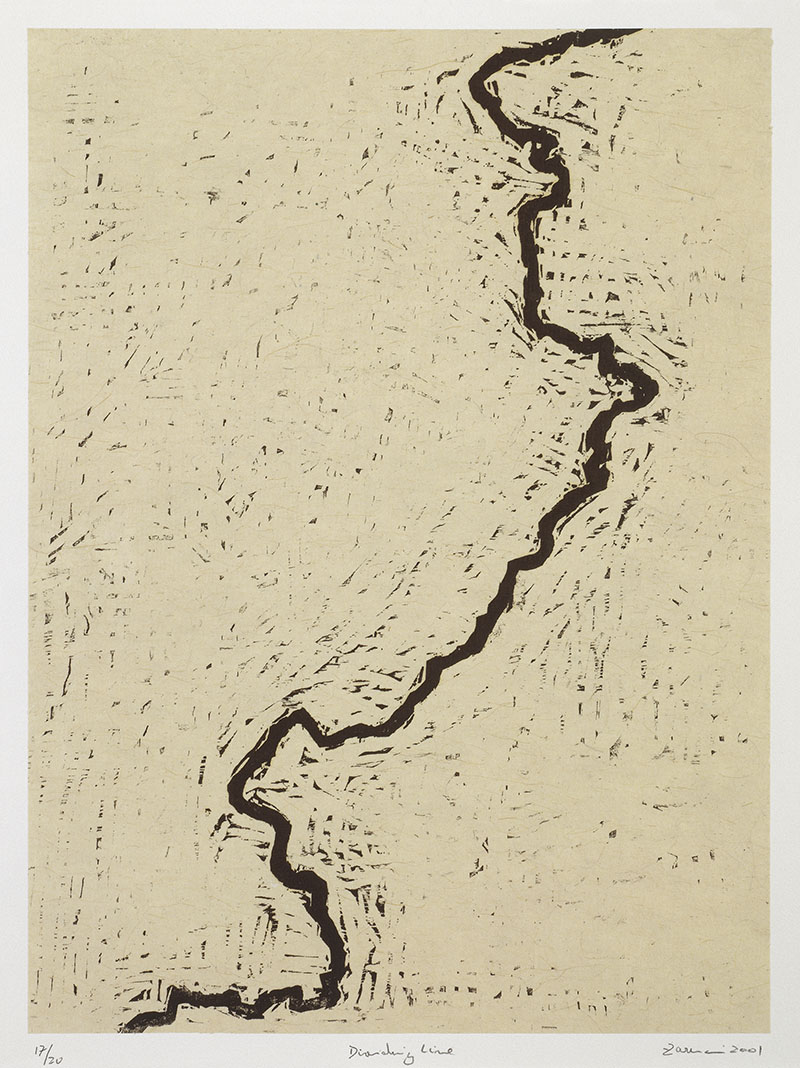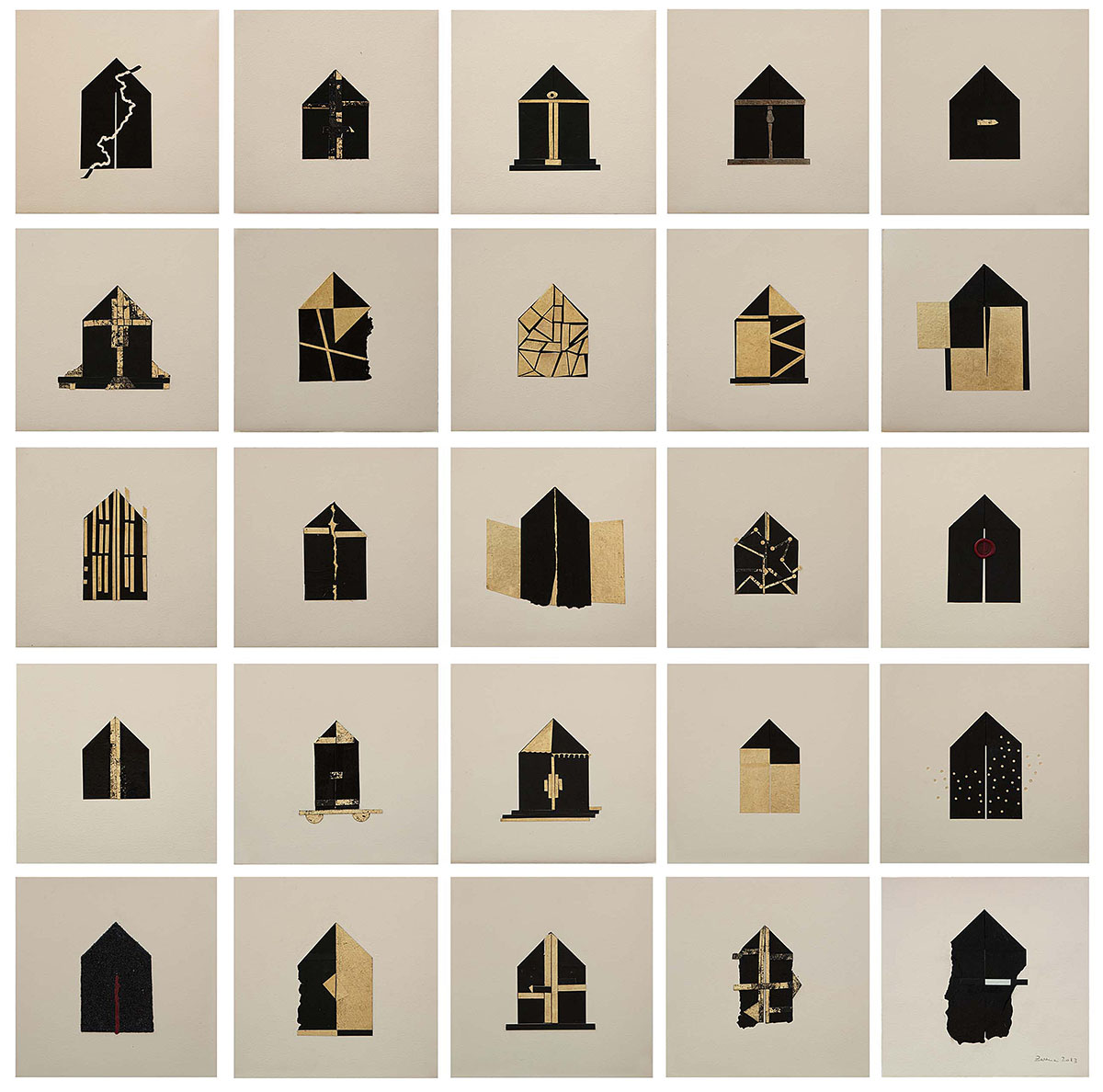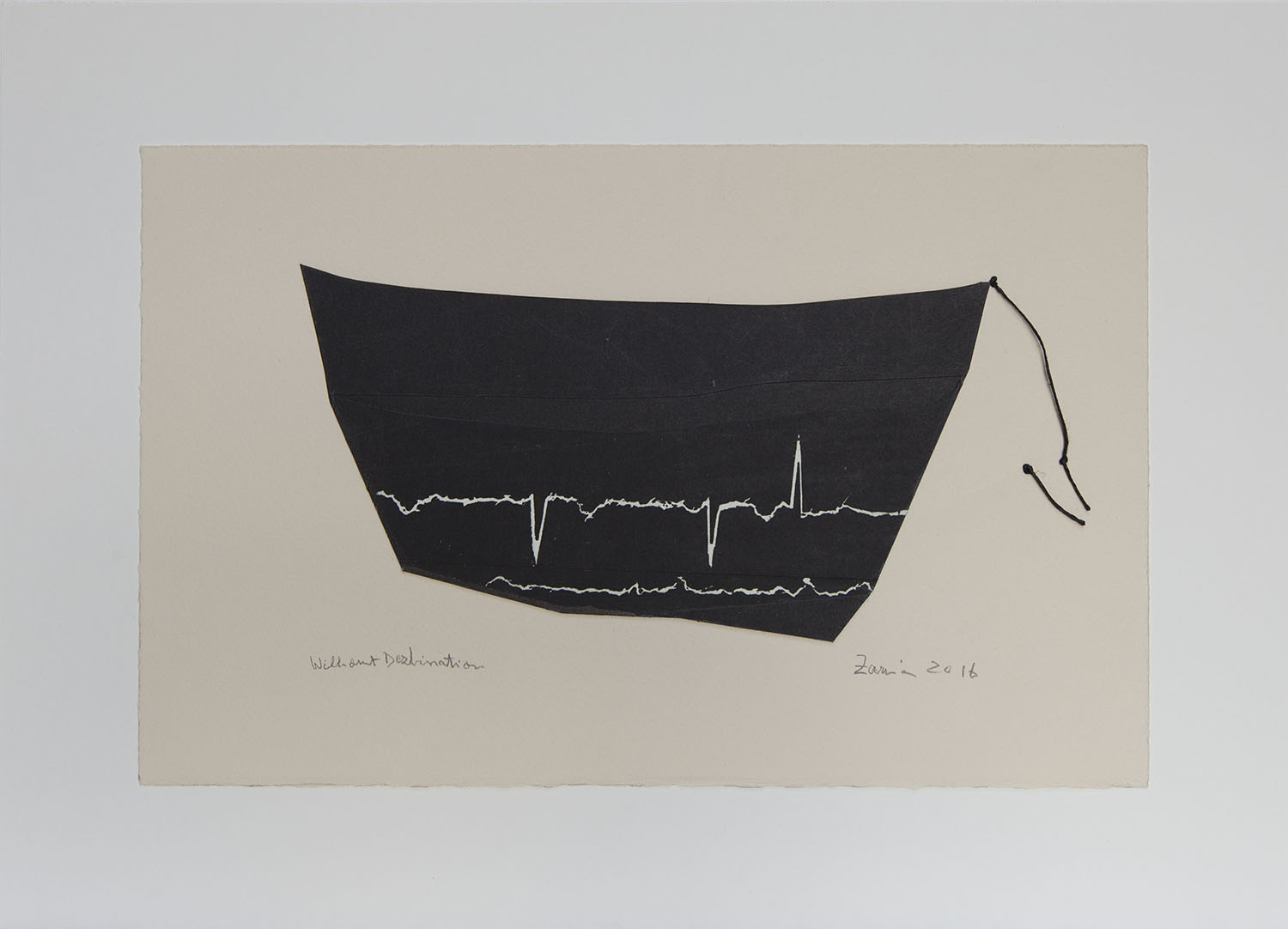ARTICLE
Zarina
Although trained as a printmaker, Zarina also produced sculptures. Her early experiments in the 1960s–70s, such as Fence (1976), Pin Drawing (1977) and Wall (1979), involved puncturing, sewing, impressing and scratching the surface of fibrous handmade paper. She took these techniques further in her sculptures from the 1980s in works like Rock (1982), Seed (1982) and Phool (1989), which are made from paper casts and terracotta but represent different objects associated with soil, giving Zarina’s work an autobiographical quality and suggesting that these objects are displaced from their expected context or fundamental nature through their rootlessness. Her work in the 1990s is even more autobiographical, such as the bronze I Went on a Journey (1991) and more notably House with Four Walls (1991), a set of seven minimalist etchings depicting key scenes from her childhood alongside single-sentence annotations; a coiled snake, a ghost and the straw mats on which her family took afternoon naps. Zarina explored this further with Home is a Foreign Place (1999), a set of thirty-six woodcut prints portraying different aspects of home in northern India and Pakistan: the threshold, the ceiling fan, the courtyard, Urdu and the floorplan of her house in Aligarh. In the 2000s, Zarina began to use references from maps as an extension of the aerial view of blueprint-like prints of her childhood home, conveying a sense of alienation. Some of the most notable works from this period include Dividing Line (2001), a woodblock print of the Indo-Pakistan border extending from one edge of the paper to the other; a line instantly recognisable to residents of those countries, but arbitrary to others; Letters from Home (2004), a set of eight prints of letters from Zarina’s sister Rani, over which she printed floor plans, elevation plans and maps composed following the shape of the text; and Travels with Rani (2008) in which she printed a list of places she visited with her family as a child and drew a borderless map of these over the names. Zarina later expanded the political scope of her work to include other regions in the developing world divided by colonial powers such as Palestine, the Rohingya pogroms and the Syrian civil war; Temporary Homes (2015), a set of tent-like forms made with folded paper tied to a sheet with thread, inspired by images of refugee camps and Without Destination (2016), a print of an electrocardiograph superimposed on an image of a boat, alluding to the forced migration of both the Rohingyas and Syrian refugees by sea.
While Zarina had been acknowledged as a significant artist among her peers, she received global acclaim only in the twenty-first century. Her most significant exhibitions include WACK!: Art and the Feminist Revolution (2007) at the Museum of Contemporary Art, Los Angeles; she participated in the first Indian pavilion at the Venice Biennale in 2011; her first retrospective Paper Like Skin which was held at the Hammer Museum, Los Angeles in 2012; Zarina: Dark Roads (2017–2018) at the Asian/Pacific/American Institute, New York University which followed her residency there and marked the seventieth anniversary of the Partition; Weaving Darkness and Silence (2018) at Gallery Espace; and a posthumous exhibition Zarina: A Life in Nine Lines | Across Decades – Borders – Geographies (2020–2021) held at the Kiran Nadar Museum of Art. Her memoirs, Directions to My House (2018), was written in collaboration with Sarah Burney. Zarina’s work is currently spread across her estate and collections at the Whitney Museum, the Metropolitan Museum, Luhring Augustine Gallery and Gallery Espace.
In April 2020, Zarina passed away at the age of eighty-two due to complications from Alzheimer’s disease.
Bibliography
Adajania, Nancy. “Flying for Truth – Celebrating the Life of Zarina Hashmi.” STIRworld, May 02, 2020. https://www.stirworld.com/think-opinions-flying-for-truth-celebrating-the-life-of-zarina-hashmi.
Cotter, Holland. “Zarina Hashmi, Artist of a World in Search of Home, Dies at 82.” The New York Times, May 05, 2020. https://www.nytimes.com/2020/05/05/arts/zarina-hashmi-dead.html.
D’Souza, Aruna. “Zarina.” 4Columns, January 26, 2018. https://www.4columns.org/d-souza-aruna/zarina.
Liebmann, Lisa. “ZARINA’S BALM.” Artforum 26, no. 5. January, 1988. https://www.artforum.com/print/198801/zarina-s-balm-34461.
Naeem, Asma. “Zarina Hashmi: Refugee Camps, Temporary Homes.” Asian Diasporic Visual Cultures and the Americas 3, no. 3 (2017): 345–53. https://repository.si.edu/bitstream/handle/10088/33927/ADVA_003_03_005_Artist-Page_Naeem.pdf.
Raza, Nada. “Zarina (1937–2020) : A fiercely independent woman artist.” The Hindu, April 26, 2020, . https://www.thehindu.com/news/national/zarina-1937-2020-a-fiercely-independent-woman-artist/article31438440.ece.
Stewart, Courtney A. “Seven Questions for Zarina Hashmi.” The Metropolitan Museum Blog, February 9, 2017. https://www.metmuseum.org/blogs/ruminations/2017/zarina-hashmi-interview.
Zamindar, Vazira Fazila-Yacoobali. “Zarina’s ‘Dark Roads’: Exile, Statelessness and the Tenacity of Nostalgia.” Third Text. Accessed July 08, 2021. http://thirdtext.org/zamindar-zarina.
“Zarina (1937–2020).” Artforum, April 26, 2020. https://www.artforum.com/news/zarina-1937-2020-82843.
“Zarina. Home Is a Foreign Place Series. 1999: MoMA.” The Museum of Modern Art. Accessed July 07, 2021. https://www.moma.org/audio/playlist/298/31.









